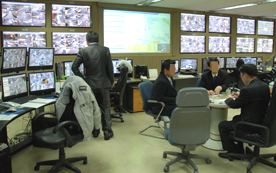Add-on products
Milestone has developed add-on products that fully integrate with XProtect to give you extra functionality. Access to add-on products are controlled by your software license code (SLC).
XProtect Access (explained)
The use of XProtect Access requires that you have purchased a base license that allows you to access this feature within your XProtect system. You also need an access control door license for each door you want to control.
You can use XProtect Access with access control systems from vendors where a vendor-specific plug-in for XProtect Access exists.
The access control integration feature introduces new functionality that makes it simple to integrate customers’ access control systems with XProtect. You get:
- A common operator user interface for multiple access control systems in XProtect Smart Client
- Faster and more powerful integration of access control systems
- More functionality for the operator (see below)
In XProtect Smart Client, the operator gets:
- Live monitoring of events at access points
- Operator aided passage for access requests
- Map integration
- Alarm definitions for access control events
- Investigation of events at access points
- Centralized overview and control of door states
- Cardholder information and management
The Audit log logs the commands that each user performs in the access control system from XProtect Smart Client.
Apart from a XProtect Access base license, you need a vendor-specific integration plug-in installed on the event server before you can start an integration
XProtect LPR (explained)
Available functionality depends on the system you are using. See https://www.milestonesys.com/solutions/platform/product-index/ for more information.
XProtect LPR offers video-based content analysis (VCA) and recognition of vehicle license plates that interacts with your surveillance system and your XProtect Smart Client.
To read the characters on a plate, XProtect LPR uses optical character recognition on images aided by specialized camera settings.
You can combine LPR (license plate recognition) with other surveillance features such as recording and event-based activation of outputs.
Examples of events in XProtect LPR:
- Trigger surveillance system recordings in a particular quality
- Activate alarms
- Match against positive/negative license plate match lists
- Open gates
- Switch on lights
- Push video of incidents to computer screens of particular security staff members
- Send mobile phone text messages
With an event, you can activate alarms in XProtect Smart Client.
XProtect Smart Wall (explained)
Available functionality depends on the system you are using. See https://www.milestonesys.com/solutions/platform/product-index/ for more information.
XProtect Smart Wall is an advanced add-on tool that enables organizations to create video walls that meet their specific security demands. Smart Wall provides an overview of all the video data in the VMS![]() Short for "Video Management Software". system and can be shared between multiple operators.
Short for "Video Management Software". system and can be shared between multiple operators.
With XProtect Smart Wall, operators can share almost any type of content available in XProtect Smart Client, for example video, images, text, alarms, and smart maps.

Initially, XProtect Smart Wall is configured by a system administrator in XProtect Management Client. This includes presets that control the layout of the Smart Wall and how cameras are distributed across the different monitors. In XProtect Smart Client, operators can change what is being displayed on the Smart Wall by applying different presets. Display changes can also be controlled by rules that automatically change the presets.
With the Smart Wall overview, operators can add specific content or whole views to Smart Wall monitors through simple drag-and-drop operations.
XProtect Transact (explained)
Available functionality depends on the system you are using. See https://www.milestonesys.com/solutions/platform/product-index/ for more information.
XProtect Transact is an add-on to Milestone's IP video surveillance solutions.
XProtect Transact is a tool for observing ongoing transactions and investigating transactions in the past. The transactions are linked with the digital surveillance video monitoring the transactions, for example to help you prove fraud or provide evidence against a perpetrator. There is a 1-to-1 relationship between the transaction lines and video images.
The transaction data may originate from different types of transaction sources, typically point of sales (PoS) systems or automated teller machines (ATM).
Milestone Open Network Bridge (explained)
ONVIF is an open, global forum that is working to standardize and secure the way that IP video surveillance products communicate. The goal is to make it easy to exchange video data. For example, to enable law enforcement, surveillance centers, or similar organizations to quickly access live and recorded video streams in any IP-based surveillance system.
Milestone Systems wants to support this goal, and has developed the Milestone Open Network Bridge toward that end. Milestone Open Network Bridge is a part of the Milestone Open Platform, and offers an interface that supports the parts of the ONVIF standard for retrieving live and recorded video from any Milestone VMS product.
This document provides the following:
- Information about the ONVIF standard and links to reference materials
- Instructions for installing and configuring the Milestone Open Network Bridge in your XProtect VMS product
- Examples of how to enable various types of ONVIF clients to stream live and recorded video from XProtect VMS products
XProtect DLNA Server (explained)
DLNA (Digital Living Network Alliance) is a standard for connecting multimedia devices. Electronic manufactures get their products DLNA certified to ensure interoperability between different vendors and devices and thereby enable them to distribute video content.
Public displays and TVs are often DLNA certified and connected to a network. They are able to scan the network for media content, connect to the device, and request a media stream to their built-in media player. XProtect DLNA Server can be discovered by certain DLNA certified devices and deliver live video streams from selected cameras to DLNA certified devices with a media player.
The DLNA devices have a live video delay of 1-10 seconds. This is caused by different buffer sizes in the devices.
XProtect DLNA Server must be connected to the same network as the XProtect system and the DLNA device must be connected to the same network as XProtect DLNA Server.

